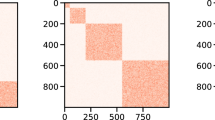Abstract
Social networks are dynamic structures in which entities and links appear and disappear for different reasons. Starting from the observation that each entity plays a more or less important role in transmitting the information inside a network, the objective of this article is to propose a method which exploits the role played by a given node to both estimate the impact of its disappearance on the information flow, and conduct network changes to restore the information flow with a similar quality as before the node disappearance. To this end, we propose a network restructuring approach that categorizes nodes into critical and non-critical classes based on their role, and hence, manages their disappearance appropriately by adding new links in a parsimonious way and selecting a substitute for a deleted critical node. As opposed to a previously defined solution, our approach adds links that are just enough to maintain the quality of the information flow within the network as before a node deletion. A prototype is designed and implemented using an open source social network analysis library (NetworkX). Its validation is conducted using network data sets with various sizes. The empirical study shows a low network update, a quite constant quality of the information flow and reasonable execution times after a node deletion.









Similar content being viewed by others
References
Aggarwal CC, Khan A, Yan X (2011) On flow authority discovery in social networks. In: SDM, pp 522–533
Ahlswede R, Ning C, Li S-YR, Yeung RW (2000) Network information flow. IEEE Trans Inf Theory 46(4):1204 –1216
Al Hasan M, Chaoji V, Salem S, Zaki M (2006) Link prediction using supervised learning. In: In proceedings of SDM 06 workshop on link analysis, counterterrorism and security
Backstrom L, Leskovec J (2011) Supervised random walks: predicting and recommending links in social networks. In: WSDM, pp 635–644
Ben-Naim E, Krapivsky PL (2007) Addition–deletion networks. J Phys A: Math Theoret 40(30):8607
Carrington PJ (2005) Models and methods in social network analysis. Structural analysis in the social sciences. Cambridge University Press. ISBN:0-521-80959-2
De Choudhury M, Lin Y-R, Sundaram H, Selçuk Candan K, Xie L, Kelliher A (2010) How does the data sampling strategy impact the discovery of information diffusion in social media? In: ICWSM
Dean J, Ghemawat S (2008) Mapreduce: simplified data processing on large clusters. Commun ACM 51:107–113
Fortunato S (2010) Community detection in graphs. Physics Reports 486(3–5):75–174. ISSN:03701573
Friedkin NE (1982) Information flow through strong and weak ties in intraorganizational social networks. Soc Netw 3(4):273–285
Gilbert E, Karahalios K (2009) Predicting tie strength with social media. In: Proceedings of the 27th international conference on human factors in computing systems, CHI ’09, pp 211–220
Girvan M, Newman MEJ (2002) Community structure in social and biological networks. Proc Natl Acad Sci USA 99(12):7821–7826
Gomez Rodriguez M, Leskovec J, Krause A (2010) Inferring networks of diffusion and influence. In: Proceedings of the 16th ACM SIGKDD international conference on knowledge discovery and data mining. KDD ’10, pp 1019–1028
Halim F, Yap RHC, Wu Y (2011) A Mapreduce-based maximum-flow algorithm for large small-world network graphs. In: ICDCS, pp 192–202
Hanneman R, Riddle M (2005) Introduction to social network methods. http://faculty.ucr.edu/hanneman/nettext/
Hussain DMA, Ahmed Z (2008) Dynamical adaptation in terrorist cells/networks. In: SCSS (2), pp 557–562
Knoke D, Yang S (2008) Social network analysis, 2nd edn. Sage, London
Krackhardt D (1990) Assessing the political landscape: structure, cognition, and power in organizations. Adm Sci Q 35(2):342–369
Kumpula JM, Onnela JP, Saramäki J, Kaski K, Kertész J (2007) Emergence of communities in weighted networks. Phys Rev Lett 99(22):228701
Lancichinetti A, Fortunato S, Kertész J (2009) Detecting the overlapping and hierarchical community structure in complex networks. New J Phys 11(3):033015
Leskovec J, Huttenlocher D, Kleinberg J (2010) Predicting positive and negative links in online social networks. In: Proceedings of the 19th international conference on World Wide Web. WWW ’10, pp 641–650
Liben-Nowell D, Kleinberg J (2003) The link prediction problem for social networks. In CIKM ’03: Proceedings of the twelfth international conference on Information and knowledge management. ACM, pp 556–559. ISBN:1-58113-723-0
Missaoui R, Negre E, Anggraini D, Vaillancourt J (2012) Network restructuring after a node removal. Int J Web Eng Technol (IJWET) (accepted)
Negre E, Missaoui R, Vaillancourt J (2011) Predicting a social network structure once a node is deleted. In: ASONAM, pp 297–304
NetworkX library (2011) http://networkx.lanl.gov/
Newman MEJ (2004) Fast algorithm for detecting community structure in networks. Phys Rev E 69(6):066133
Stanford dataset (2009) http://snap.stanford.edu/data/as.html
Tantipathananandh C, Wolf TB, Kempe D (2007) A framework for community identification in dynamic social networks. In: KDD ’07: Proceedings of the 13th ACM SIGKDD international conference on Knowledge discovery and data mining. ACM, pp 717–726. ISBN:978-1-59593-609-7
Toivonen R, Kovanen L, Kivelä M, Onnela JP, Saramäki J, Kaski K (2009) A comparative study of social network models: network evolution models and nodal attribute models. Soc Netw 31(4):240–254. ISSN:03788733
Tylenda T, Angelova R, Bedathur S (2009) Towards time-aware link prediction in evolving social networks. In: The 3rd SNA-KDD workshop ’09 (SNA-KDD’09)
Wasserman S, Faust K (1994) Social network analysis : methods and applications, 1st edn. Structural analysis in the social sciences. Cambridge University Press, Cambridge
Wei F, Qian W, Wang C, Zhou A (2009) Detecting overlapping community structures in networks. World Wide Web 12:235–261. ISSN:1386-145X
Wu F, Huberman BA, Adamic LA, Tyler JR (2004) Information flow in social groups. Phys A: Stat Mech Appl 337(1–2):327–335
Yang J, Leskovec J (2010) Modeling information diffusion in implicit networks. In: ICDM, pp 599–608
Acknowledgments
Idrissa Sarr is grateful to “Programme canadien de bourses de la Francophonie” (PCBF) of the Canadian International Development Agency (CIDA) for the postdoctoral fellowship while Rokia Missaoui acknowledges the financial support of the Natural Sciences and Engineering Research Council of Canada (NSERC).
Author information
Authors and Affiliations
Corresponding author
Rights and permissions
About this article
Cite this article
Sarr, I., Missaoui, R. Managing node disappearance based on information flow in social networks. Soc. Netw. Anal. Min. 3, 299–311 (2013). https://doi.org/10.1007/s13278-012-0071-y
Received:
Accepted:
Published:
Issue Date:
DOI: https://doi.org/10.1007/s13278-012-0071-y




